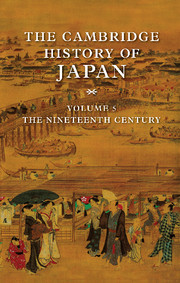Book contents
- Frontmatter
- Introduction
- 1 Japan in the early nineteenth century
- 2 The Tempō crisis
- 3 Late Tokugawa culture and thought
- 4 The foreign threat and the opening of the ports
- 5 The Meiji Restoration
- 6 Opposition movements in early Meiji, 1868–1885
- 7 Japan's turn to the west
- 8 Social change
- 9 Economic change in the nineteenth century
- 10 Meiji political institutions
- 11 Meiji conservatism
- 12 Japan's drive to great-power status
- Works Cited
- Index
- References
7 - Japan's turn to the west
Published online by Cambridge University Press: 28 March 2008
- Frontmatter
- Introduction
- 1 Japan in the early nineteenth century
- 2 The Tempō crisis
- 3 Late Tokugawa culture and thought
- 4 The foreign threat and the opening of the ports
- 5 The Meiji Restoration
- 6 Opposition movements in early Meiji, 1868–1885
- 7 Japan's turn to the west
- 8 Social change
- 9 Economic change in the nineteenth century
- 10 Meiji political institutions
- 11 Meiji conservatism
- 12 Japan's drive to great-power status
- Works Cited
- Index
- References
Summary
Although Japan was never a “closed country” in the sense that sakoku literally implies, it did awaken from two hundred years of substantial “national isolation” in the last half of the nineteenth century to devote its full energy toward the realization of one goal – the establishment of a modern nation-state. This effort itself is better evidence of Japan's “turn to the West” than anything else, for the concept of a modern nation-state had yet to manifest itself in any non-Western country. In economic terms, a modern nation-state is a state that has experienced an industrial revolution; in social terms, it is a state with a centralized political system under which popular participation is structured through the parliamentary institutions of a constitutional order. By any measure, such characteristics of a state are thoroughly Western in nature and origin.
These distinguishing characteristics were not to be found in the Tokugawa bakuhan state. Nineteenth-century Japanese society was pre-industrial, and its economy was based on forms of production that depended on animate rather than mechanical sources of power. A large bourgeoisie did exist to carry on commercial and financial enterprise, but it was excluded from participating in political decisions. The Tokugawa political structure was composed of a bureaucracy, representing feudally privileged classes that operated within a system that reconciled theoretically incompatible elements of feudalism and absolute shogunal “monarchy.” Despite Japan's high level of cultural homogenity – or perhaps because of it – the concept of a people as a “nation” that participated actively in the affairs of a “state” was unknown.
- Type
- Chapter
- Information
- The Cambridge History of Japan , pp. 432 - 498Publisher: Cambridge University PressPrint publication year: 1989
References
- 6
- Cited by

